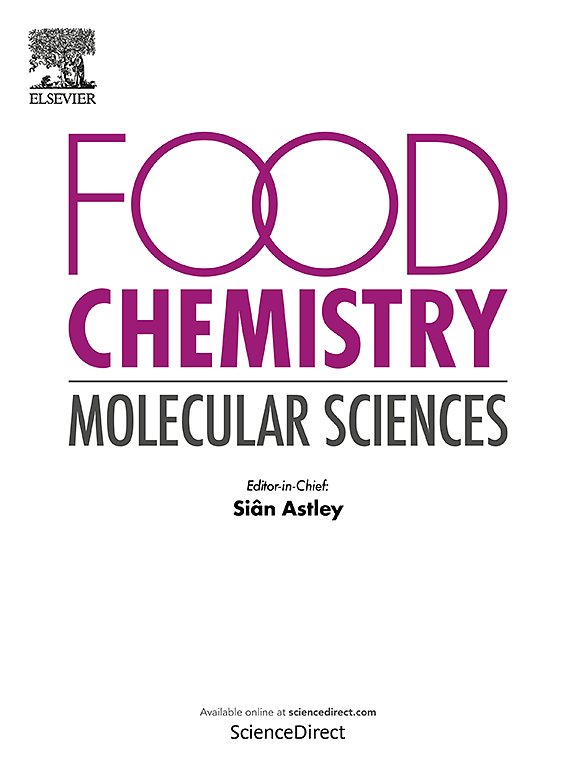Quantity of Cu(II) ions in a copper pot by a DNAzyme-based fluorescent sensor
IF 4.1
Q2 FOOD SCIENCE & TECHNOLOGY
引用次数: 0
Abstract
Copper deficiency can adversely impact health, and using copper cookware can help supplement copper ions. In this study, we have developed a fluorescent Cu(II) sensor using an efficient DNAzyme, a novel cofactor 2-mercaptoethanol and an optimized fluorophore. This sensor has demonstrated high sensitivity, with a linear detection range of 30 nM-50 μM and a detection limit of 3.4 nM. Furthermore, it has shown high selectivity for Cu(II) ions and possesses excellent anti-interference ability against 10,000-fold excess of Ca(II) and Mg(II), etc. These features allow the sensor suitable for quantitatively detecting Cu(II) in a copper pot, where a maximum Cu(II) concentration of 40.0 μM was achieved upon the addition of pickled cucumber. Our findings suggest that acidic conditions are beneficial for increasing Cu(II) content in the cooking medium. This provides a scientific basis for using copper cookware as a means to increase dietary copper intake.

基于dnazyme的荧光传感器测定铜罐中Cu(II)离子的数量
缺铜会对健康产生不利影响,使用铜炊具可以帮助补充铜离子。在这项研究中,我们利用一种高效的DNAzyme、一种新型的辅助因子2-巯基乙醇和一种优化的荧光团开发了一种荧光Cu(II)传感器。该传感器具有较高的灵敏度,线性检测范围为30 nM-50 μM,检测限为3.4 nM。此外,它对Cu(II)离子有很高的选择性,对Ca(II)、Mg(II)等超过1万倍的离子具有优异的抗干扰能力。这些特性使得该传感器适用于定量检测铜(II)在铜锅中,其中最大的Cu(II)浓度达到40.0 μM的添加酸黄瓜。我们的研究结果表明,酸性条件有利于增加烹饪介质中Cu(II)的含量。这为使用铜炊具作为增加膳食铜摄入量的手段提供了科学依据。
本文章由计算机程序翻译,如有差异,请以英文原文为准。
求助全文
约1分钟内获得全文
求助全文
来源期刊

Food Chemistry Molecular Sciences
Agricultural and Biological Sciences-Food Science
CiteScore
6.00
自引率
0.00%
发文量
83
审稿时长
82 days
期刊介绍:
Food Chemistry: Molecular Sciences is one of three companion journals to the highly respected Food Chemistry.
Food Chemistry: Molecular Sciences is an open access journal publishing research advancing the theory and practice of molecular sciences of foods.
The types of articles considered are original research articles, analytical methods, comprehensive reviews and commentaries.
Topics include:
Molecular sciences relating to major and minor components of food (nutrients and bioactives) and their physiological, sensory, flavour, and microbiological aspects; data must be sufficient to demonstrate relevance to foods and as consumed by humans
Changes in molecular composition or structure in foods occurring or induced during growth, distribution and processing (industrial or domestic) or as a result of human metabolism
Quality, safety, authenticity and traceability of foods and packaging materials
Valorisation of food waste arising from processing and exploitation of by-products
Molecular sciences of additives, contaminants including agro-chemicals, together with their metabolism, food fate and benefit: risk to human health
Novel analytical and computational (bioinformatics) methods related to foods as consumed, nutrients and bioactives, sensory, metabolic fate, and origins of foods. Articles must be concerned with new or novel methods or novel uses and must be applied to real-world samples to demonstrate robustness. Those dealing with significant improvements to existing methods or foods and commodities from different regions, and re-use of existing data will be considered, provided authors can establish sufficient originality.
 求助内容:
求助内容: 应助结果提醒方式:
应助结果提醒方式:


